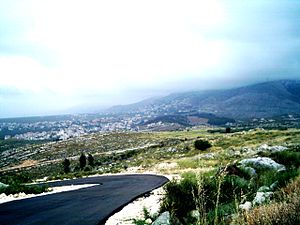After the death of the last titular patriarch of Antioch in 702, John Maron became the only Chalcedonian patriarch holding the title until the Eastern Orthodox Church reestablished the seat in 742. John Maron died in 707 and was buried in Kfarhay. He is seen as a Saint and the founder of the Maronite Church and his feast day is celebrated on March 2nd. [16]
Although we are not trying to deal in warfare, a unique battle we shall mention for the impact it has left, this is the battle of south East Amyun, in the year 694, precipitated by mountain dwellers of Maronite Christian faith, as a revenge against the army of Justinian II of Byzantium, for the destruction of a monastery sheltering 350, monks adherents of Marūn, in northern Syria, near Apamea (Afamiyaħ), 350 km (217 mi) from Amyun. The battle was fought by a group of Marūn adherents who had sought refuge formerly in the mountains facing Amyun, from the east and made a surprise attack, under the leadership of Yuhanna Marūn, against a contingent of the Byzantine army, which was defeated and the Marūn adherents returned to their mountainous sites, to stay in a state of isolation, which marked and stamped the history of the Maronites as dwellers of the mountains of Lebanon, by isolationism, that persisted among the mountainous adherents up to our present days and had touched their performances and deliberations in modern Lebanon.
